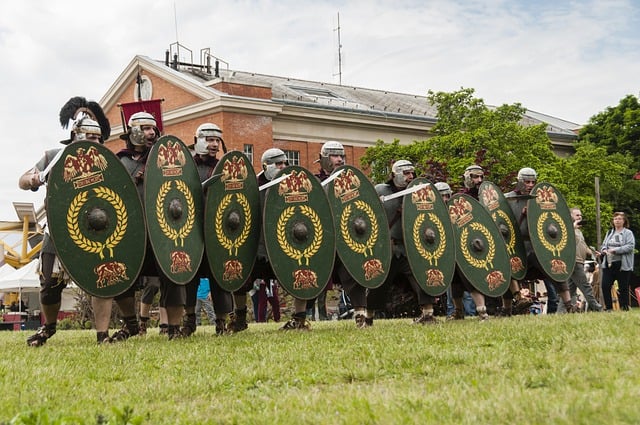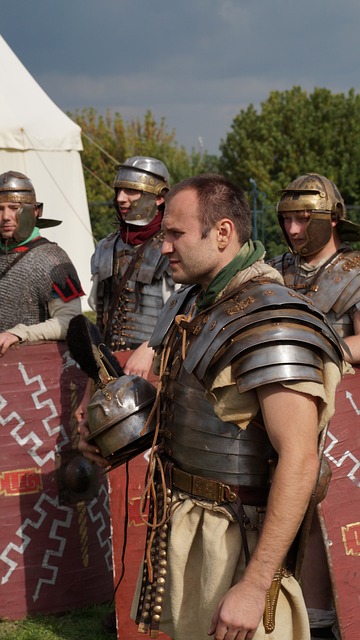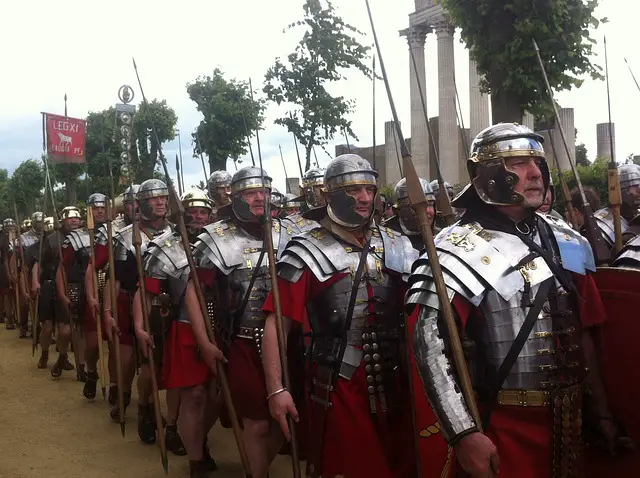Legionaries were Roman citizens serving in the Roman legions, while auxiliaries were non-citizens providing support to the legions in the Roman army.
TL:DR Legionaries Vs. auxiliaries
Legionaries were Roman citizens who served as heavy infantry soldiers in the legions. They underwent rigorous training and were highly skilled in combat tactics. Their main responsibilities included frontline battles, siege warfare, and maintaining order within conquered territories. Legionaries formed the core fighting force of the Roman army, showcasing bravery and unwavering loyalty to Rome.
Auxiliaries were recruited from non-Roman provinces or allied tribes. They brought a wide range of specialized skills such as archery, cavalry expertise, or knowledge of local terrain that complemented the strengths of legionary forces. Auxiliaries often served alongside legionaries but had different roles depending on their specific skill sets.
Definition of Legionaries

Legionaries, the epitome of Roman military might, were the backbone of the Roman legions. These highly trained and disciplined soldiers formed the core infantry units in ancient Rome. Comprising around 5,000 men, a legion was divided into several cohorts, with each cohort consisting of centuries led by centurions.
These battle-hardened warriors wore distinctive armor – a metal cuirass for protection and a plumed helmet to intimidate their enemies. Armed with gladii (short swords) and pilums (javelins), they were adept at both close-quarters combat and skirmishes from a distance.
But being a legionary was more than just about physical strength; it required mental fortitude as well. They underwent rigorous training that instilled discipline, efficiency, and loyalty to their commanding officers and ultimately to Rome itself.
The life of a legionary was not an easy one – constant drills, marching long distances carrying heavy equipment under scorching sun or freezing cold weather conditions tested their endurance. Yet they remained steadfast in their duty to defend the empire against external threats.
In battle formations known as maniples or cohorts, these formidable soldiers would march forward with unwavering determination on vast battlefield landscapes across Europe and beyond.
Definition of Auxiliaries

Auxiliaries were an integral part of the Roman military system, serving alongside the legionaries to ensure the dominance and expansion of the empire. These auxiliary troops were recruited from non-Roman citizens living in provinces under Roman control.
Unlike legionaries who were primarily Roman citizens, auxiliaries came from various backgrounds and ethnicities. They included both infantry and cavalry units, each with their own unique skills and specialties. While some auxiliaries fought as light infantry or archers, others served as skilled horsemen or even charioteers.
One key difference between auxiliaries and legionaries was their legal status within the Roman Empire. Legionaries held full Roman citizenship rights while serving in the military, whereas auxiliaries did not have these same privileges. However, after completing their service in the army, many auxiliary soldiers received a grant of citizenship for themselves and their families as a reward for their loyalty.
Another distinction lies in how they were organized within the military structure. Legions typically consisted of around 5,000 men divided into cohorts led by centurions. In contrast, auxiliary units varied greatly in size depending on location and need.
Despite these differences, both legionaries and auxiliaries played critical roles on the battlefield. The main responsibility of legions was to engage directly with enemy forces using heavy infantry tactics such as shield walls and close combat formations. On the other hand, auxiliaries often provided support to legions through reconnaissance missions or skirmishes against enemy flanks.
Legionaries Vs. auxiliaries – Key differences
| Aspect | Legionaries | Auxiliaries |
|---|---|---|
| Citizenship Status | Roman citizens, offering full Roman rights and privileges | Non-Roman citizens, often recruited from conquered provinces, without full Roman citizenship |
| Role | Served as core infantry in the Roman legions, typically Roman citizens by birth | Provided supplementary support to the legions, often in specialized roles such as cavalry or archers |
| Training | Received rigorous Roman military training and discipline | Trained in a variety of specialized skills, including archery, cavalry, and other support functions |
| Leadership | Commanded by Roman officers and centurions | Led by Roman officers, but lower-ranking positions often filled by non-citizens |
| Composition | Comprised the main combat force of the Roman army, known for their discipline and cohesion | Made up the auxiliary units, which added diversity and specialized capabilities to the legions |
| Citizenship Rewards | Earning citizenship was not a primary incentive, as they were already citizens | Service in the auxiliaries could lead to the granting of Roman citizenship as a reward |
| Deployment | Often stationed in the core Roman territories and provinces | Frequently deployed to the frontiers and border regions of the Roman Empire |
| Contribution | Formed the backbone of the Roman legions and were critical in Roman military campaigns | Provided essential support to the legions and enhanced their overall effectiveness in battle |
Roles and Responsibilities of Legionaries
Legionaries were the core infantry soldiers in the Roman legions, and they had various roles and responsibilities, including:
- Frontline Infantry: Legionaries were the primary combat troops in the Roman legions. They fought in the front lines of battles, using their weapons and training to engage and defeat the enemy.
- Discipline and Formation: Maintaining discipline and formation was crucial. They had to march in tight formations, like the famous Roman tortoise or testudo, which provided protection from enemy projectiles.
- Construction and Engineering: Legionaries were skilled in construction and engineering. They built fortifications, roads, bridges, and other infrastructure as needed during military campaigns.
- Weaponry: They were trained in the use of a variety of weapons, including the gladius (short sword), pilum (javelin), and scutum (shield). They were also proficient in siege equipment when required.
- Tactics: Legionaries had to execute various tactical formations and maneuvers on the battlefield. These tactics included the famous Roman lines and maniples, allowing for adaptability in different combat situations.
- Camp Life: They were responsible for setting up and maintaining the legion’s camp. This involved constructing fortifications, digging trenches, and ensuring the safety and security of the camp.
- Training and Drilling: Regular training and drilling were essential to maintain their combat skills and discipline. Drills and exercises prepared them for combat and maintained their cohesion.
- Marching: Marching long distances was a common part of a legionary’s life. They had to cover vast distances on foot, often carrying heavy equipment and supplies.
- Follow Chain of Command: Legionaries had to follow the orders of their centurions and higher-ranking officers. Discipline was strict, and insubordination was not tolerated.
- Frontier Duty: Some legionaries were stationed on the frontiers of the Roman Empire, where they had the additional responsibility of protecting the borders from external threats.
- Garrison Duty: When not engaged in active campaigns, legionaries often served in garrisons within the Roman provinces, maintaining order and security.
- Cohesion and Brotherhood: Legionaries formed strong bonds with their fellow soldiers and had a sense of brotherhood and camaraderie within their units.
Roles and Responsibilities of Auxiliaries
Auxiliaries in the Roman army had specific roles and responsibilities that complemented the legionaries. They were often non-citizens who provided essential support and specialized skills. Their roles included:
- Specialized Units: Auxiliaries served in specialized units, such as cavalry, archers, light infantry, and other support roles, depending on their skills and background.
- Cavalry: Many auxiliaries were cavalry units known as “ala,” which played a crucial role in reconnaissance, pursuit, and flanking maneuvers during battles.
- Archers: Archery units, often recruited from regions known for skilled archers, provided long-range support and ranged firepower.
- Skirmishers: Light infantry units excelled at skirmishing and hit-and-run tactics, harassing enemy forces and disrupting their formations.
- Border Defense: Auxiliaries stationed on the frontiers of the Roman Empire were responsible for border defense and monitoring potential threats from neighboring regions.
- Scouting and Reconnaissance: They conducted scouting and reconnaissance missions to gather intelligence about enemy movements and territories.
- Local Knowledge: Many auxiliaries had local knowledge of the areas where they served, which was invaluable for understanding the terrain and local populations.
- Translators: Auxiliaries often included individuals who could serve as translators and intermediaries in regions where Latin or Greek were not commonly spoken.
- Construction and Engineering: Some auxiliaries were skilled in construction and engineering, assisting with the building of fortifications and infrastructure.
- Allied Troops: Auxiliaries included allied or client states’ troops who provided military support to Rome as part of agreements and alliances.
- Flexibility: Auxiliaries were known for their flexibility and adaptability, as they could fill various roles and adapt to different combat situations.
- Support for Legions: Their support enhanced the effectiveness of the Roman legions by providing additional capabilities, diversifying the Roman forces, and serving in auxiliary units alongside the core legionaries.
Image Credits
Featured Image By – Judith Meyer from Pixabay
Image 1 By – István Károly Bőcs from Pixabay
Image 2 By – Robert from Pixabay









